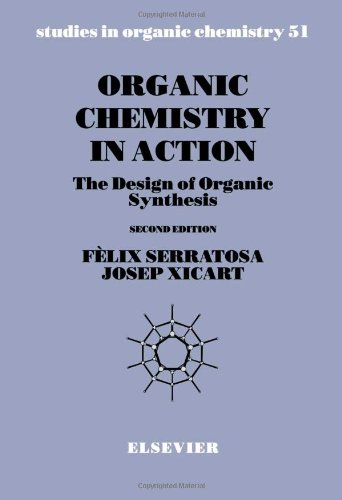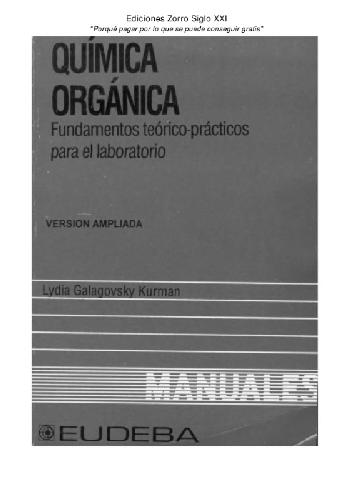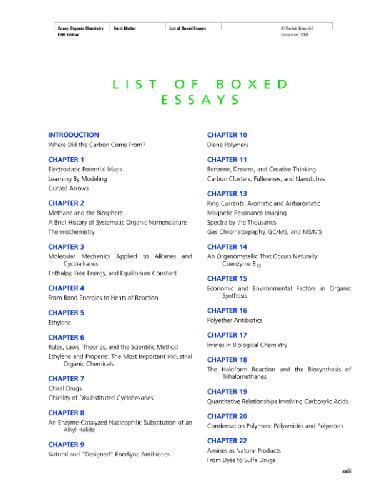F. Serratosa, J. Xicart9780444819352, 0444819355
Some new material has been added, the more significant changes being:
1) The book has been restructured into two well-differentiated sections: Part A, dealing with conventional organic synthesis, and Part B, devoted exclusively to computer-assisted organic synthesis and based on the former Chapter 11 and Appendices 2, 3 and 4 of the first edition. As decided in advance, Part B was to be the sole responsibility of Dr. Josep Xicart, who prepared the first versions of the CHAOS (Computerisation and Heuristics Applied to Organic Synthesis) program under the direction of Professor Serratosa.
2) In Chapter 1, emphasis is placed on new objectives and targets, as well as on the role that organic synthesis should play in the future in new areas of supramolecular chemistry and bioorganic chemistry.
3) A more extended discussion on synthetic methods and strategies based on radical carbon-carbon bond-forming reactions has been included (Chapter 7).
4) Some new examples to illustrate the heuristic principles have been incorporated (Chapter 4).
5) The chapter on alicyclic stereoselection has been split into two chapters (9 and 10). Chapter 10, which is exclusively devoted to Sharpless’s asymmetric epoxidation and dihyroxylation, has been written de novo. The most recent advances in catalytic stereoselective aldol are incorporated in Chapter 9.
6) In Chapter 11, which is new, the aim is to firstly, present a panoramic view of the most important methods for preparation of optically pure compounds in industrial scale (chirotechnology) and secondly, to give a brief insight into the new biological synthetic methodologies, such as the use of enzymes and catalytic monoclonal antibodies or abzymes, which are becoming more and more important and familiar to the synthetic organic chemist.
7) The chapter dealing with examples of retrosynthetic analysis and the corresponding total synthesis has been enlarged and includes new syntheses of natural products (Chapter 13).
8) The former Chapter 11 and Appendices 2, 3 and 4 devoted to computer assisted organic synthesis have been rewritten and constitute now Part B of the book. The following changes have been introduced: i) CHAOS version 3.0 for Macintosh and version 1.0 for PC Windows® substitute CHAOS version 2.0 for IBM PC and compatibles, ii) The corresponding Instruction Manuals and Disconnection Tables of these new versions are included, iii) two 3½ inch diskettes with the new versions of CHAOS and CHAOSDBASE replace the diskette of version 2.0, iv) a new Appendix (Appendix B-1) with a brief introduction to Ugi’s Theory of Constitutional Chemistry and to the programs EROS and IGOR has also been added.
9) The main improvements in CHAOS version 3.0 for Macintosh are: i) The unique numbering or canonical matrices, ii) new disconnections, which are more selective, iii) besides RINGS and SYNTHETICALLY SIGNIFICANT RINGS, the new version gives, if required, the PRIMARY RINGS. Other new options are SELECT and RESIZE in the menu EDIT, by which one can select part of a synthetic sequence or resize the molecule drawing, iv) the possibility to introduce new disconnections from inside the program CHAOS itself and work (if desired) with one’s own chemistry, through CHAOSBASE. The aim of this program is to create DATABASES of new DISCONNECTIONS. Such DATABASES can be opened from the program CHAOS in such a manner that it allows to disconnect molecules according to the DISCONNECTIONS defined in the DATABASE (instead of disconnecting according to predefined ones implemented in CHAOS).
10) Mistakes and errors detected in the first edition have been corrected.
Table of contents :
Organic Chemistry in Action: The Design of Organic Synthesis……Page 4
Copyright Page……Page 5
Studies in Organic Chemistry……Page 6
Preface to the First Edition……Page 8
Foreword to the Second Edition……Page 10
Preface to the Second Edition……Page 12
Complementary Comments and Acknowledgements……Page 13
CONTENTS……Page 14
PART A: THE DESIGN OF ORGANIC SYNTHESIS……Page 28
1.1. The chemical and the philosophical concept of “synthesis”: from Aristotle to Kant……Page 29
1.2. Organic synthesis as a heuristic activity……Page 31
1.3. Pure substances. Language: The Classical Structural Theory……Page 32
1.4. The objectives of organic synthesis……Page 36
1.5. New times, new targets……Page 39
1.6. Synthesis as a sequence of unequivocal steps. Economy: conversion, selectivity and yield. Starting materials……Page 41
1.7. Carbon skeleton, functional group manipulation and stereochemical control. Rule of maximum simplicity……Page 46
1.8. Molecular complexity and synthetic analysis……Page 51
REFERENCES……Page 54
Appendix A-1 GRAPH THEORY. MOLECULAR COMPLEXITY INDICES……Page 57
REFERENCES……Page 64
2.1. Some general remarks on the reactivity of organic compounds……Page 65
2.2. Molecules as ionic aggregates. The Lapworth-Evans model……Page 67
2.3. Classification of functional groups according to D. A. Evans……Page 70
2.4. Consonant and dissonant bifunctional relationships……Page 77
REFERENCES……Page 82
3.1. The retrosynthetic process. Methodologies for the design of organic synthesis. The synthesis tree……Page 84
3.2. Biogenetic considerations. Biomimetic synthesis……Page 90
3.3. Mass Spectra and the Retro-Mass Spectral synthesis……Page 92
3.5. Structural synthetic analysis, simplification and generation of the intermediate precursors of the “synthesis tree”. Principle of microscopic reversibility……Page 93
3.6. Auxiliary. physical techniques in the synthesis of organic compounds……Page 101
REFERENCES……Page 105
4.1. Symmetry……Page 108
4.2. Functional groups……Page 115
4.3. The carbon skeleton: chains, rings and appendages……Page 128
REFERENCES……Page 133
5.1. Illogical disconnections: reactivity inversion……Page 136
5.2. Plausible disconnections: dissonant three-membered rings……Page 149
5.3. Sigmatropic rearrangements……Page 163
5.4. Reconnection of bifunctional dissonant systems to rings……Page 168
5.5. Homolytic disconnections: couplings involving electron-transfer……Page 169
REFERENCES……Page 180
CHAPTER 6. MONOCYCLIC AND POLYCYCLIC SYSTEMS……Page 183
6.1. Retro-annulations……Page 185
6.2. Cycloreversions: pericyclic and cheletropic disconnections. The Woodward-Hoffmann rules……Page 193
6.3. Heterocyclic compounds……Page 199
REFERENCES……Page 205
7.1. Rearrangements and internal fragmentations……Page 208
7.2. Bridged systems……Page 216
REFERENCES……Page 238
8.1. Introduction……Page 241
8.2. Specificity, selectivity, order and negative entropy……Page 245
8.3. Diastereoselectivity in monocyclic and polycyclic systems……Page 247
REFERENCES……Page 256
9.1. Temporary bridges and auxiliary rings as control elements in acyclic diastereoselection……Page 257
9.2. Diastereoselective control through highly ordered transition states……Page 261
9.3. Enantioselective control……Page 270
REFERENCES……Page 300
10.1. Epoxidation of olefinic double bonds……Page 304
10.2. Asymmetric dihydroxylation of alkenes using osmium tetroxide……Page 310
REFERENCES……Page 316
11.1. Enantioselectivity in industry. An overview……Page 319
11.2. Asymmetric synthesis……Page 320
11.3. Enzymatic methods……Page 323
REFERENCES……Page 341
12.1. Control elements……Page 344
12.2. Logic-centred synthetic analysis methodology: Summary……Page 356
12.3. General strategies……Page 359
REFERENCES……Page 360
CHAPTER 13. SELECTED ORGANIC SYNTHESES……Page 364
13.1. TWISTANE……Page 365
REFERENCES……Page 379
13.2. LUCIDULINE……Page 380
REFERENCES……Page 396
13.3. CARYOPHYLLENES……Page 397
13.4. SWAINSONINE: Sharpless synthesis……Page 407
13.5. POLYENE MACROLIDE ANTIBIOTICS AMPHOTERICIN B AND NYSTATIN A1……Page 413
REFERENCES……Page 417
13.6. TAXOL……Page 418
REFERENCES……Page 434
PART B: COMPUTER-ASSISTED ORGANIC SYNTHESIS……Page 436
CHAPTER 14. COMPUTERS, COMPUTATION, COMPUTERISATION AND ARTIFICIAL INTELLIGENCE. THE “EXPLORATION TREE”…….Page 437
14.1. Software available for computer-assisted organic synthesis……Page 439
14.2. CHAOS and CHAOSBASE, a heuristic aid for designing organic synthesis……Page 442
REFERENCES……Page 456
Appendix: B-1 UGI’S THEORY OF CHEMICAL CONSTITUTION: EROS AND IGOR……Page 459
REFERENCES……Page 465
1. INTRODUCTION……Page 466
2. RUNNING THE CHAOS PROGRAM……Page 468
3. RUNNING THE CHAOSBASE PROGRAM……Page 501
Group 1: Preliminary……Page 532
Group 2: Monofunctional……Page 534
Group 3: Consonant……Page 536
Group 4: Rings……Page 539
Group 5: Dissonant……Page 541
Group 6: Finals……Page 544
Group 7: Heterocyclic disconnections……Page 547
Appendix B-4 SUGGESTED EXERCISES TO BE SOLVED BY CHAOS……Page 549
SUBJECT INDEX……Page 552







Reviews
There are no reviews yet.